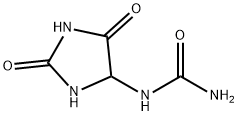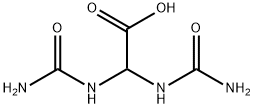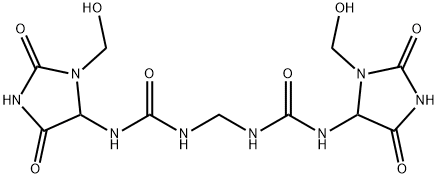Allantoin , 98% , 97-59-6
Synonym(s):
5-Ureidohydantoin;Allantoin;Glyoxylic(acid) diureide;NSC 7606
CAS NO.:97-59-6
Empirical Formula: C4H6N4O3
Molecular Weight: 158.12
MDL number: MFCD00005260
EINECS: 202-592-8
| Pack Size | Price | Stock | Quantity |
| 25G | RMB29.60 | In Stock |
|
| 100G | RMB48.00 | In Stock |
|
| 500G | RMB142.40 | In Stock |
|
| 1KG | RMB255.20 | In Stock |
|
| 5kg | RMB959.20 | In Stock |
|
| others | Enquire |
PRODUCT Properties
| Melting point: | 230 °C (dec.) (lit.) |
| Boiling point: | 283.17°C (rough estimate) |
| Density | 1.6031 (rough estimate) |
| refractive index | 1.8500 (estimate) |
| Flash point: | 230-234°C |
| storage temp. | 2-8°C |
| solubility | H2O: soluble0.1g/10 mL, clear, colorless |
| pka | 8.96(at 25℃) |
| form | Powder |
| color | White |
| Odor | odorless, tasteless |
| Water Solubility | Slightly soluble in water. Freely soluble in alkalis |
| Decomposition | 230-234 ºC |
| Merck | 14,258 |
| BRN | 102364 |
| Stability: | Stable. Incompatible with strong oxidizing agents. |
| InChIKey | POJWUDADGALRAB-UHFFFAOYSA-N |
| LogP | -2.26 at 20℃ |
| CAS DataBase Reference | 97-59-6(CAS DataBase Reference) |
| NIST Chemistry Reference | Urea, (2,5-dioxo-4-imidazolidinyl)-(97-59-6) |
| EPA Substance Registry System | Allantoin (97-59-6) |
Description and Uses
Allantoin is a product of purine and uric acid metabolism. It is formed through oxidation of uric acid by urate oxidase in most mammals but is formed only through non-enzymatic oxidation by free radicals in humans. Urinary levels of allantoin are increased prior to the onset of Alzheimer’s disease symptoms in mice expressing mutations in amyloid precursor protein and tau (APP/tau) but not during the early/middle stage of the disease, indicating its potential use as a biomarker for predicting Alzheimer’s disease onset. Due to the formation of allantoin by free radicals in humans, increased urinary levels are a potential biomarker for oxidative stress status.
diuretic
Safety
| Symbol(GHS) |  GHS07 |
| Signal word | Warning |
| Hazard statements | H302 |
| Precautionary statements | P301+P312+P330 |
| Hazard Codes | Xn,Xi |
| Risk Statements | 22-36/37/38 |
| Safety Statements | 22-24/25-36-26 |
| WGK Germany | 1 |
| RTECS | YT1600000 |
| TSCA | Yes |
| HS Code | 29332100 |
| Hazardous Substances Data | 97-59-6(Hazardous Substances Data) |





